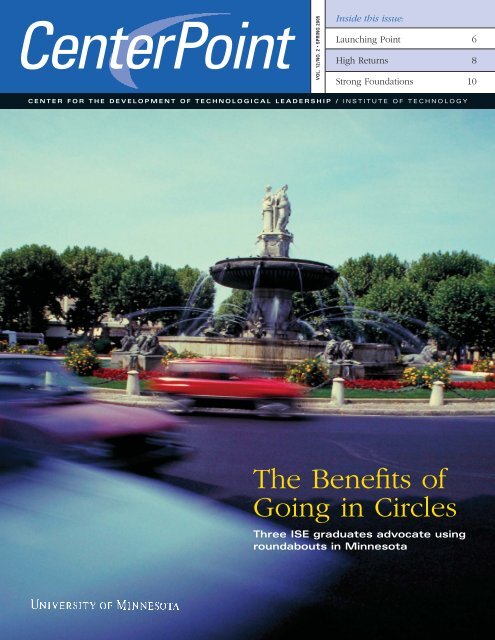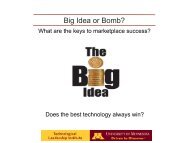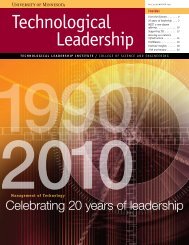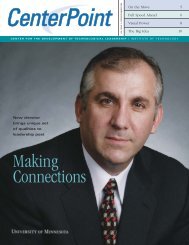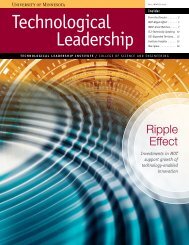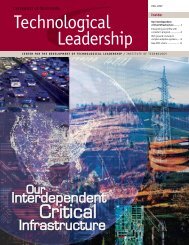Spring 2005 - Technological Leadership Institute - University of ...
Spring 2005 - Technological Leadership Institute - University of ...
Spring 2005 - Technological Leadership Institute - University of ...
You also want an ePaper? Increase the reach of your titles
YUMPU automatically turns print PDFs into web optimized ePapers that Google loves.
CenterPoint<br />
VOL. 12/NO. 2 • SPRING <strong>2005</strong><br />
Inside this issue:<br />
Launching Point 6<br />
High Returns 8<br />
Strong Foundations 10<br />
CENTER FOR THE DEVELOPMENT OF TECHNOLOGICAL LEADERSHIP / INSTITUTE OF TECHNOLOGY<br />
The Benefits <strong>of</strong><br />
Going in Circles<br />
Three ISE graduates advocate using<br />
roundabouts in Minnesota
ISE<br />
Three graduates advocate using roundabouts in Minnesota<br />
THE<br />
BENEFITS<br />
OF<br />
Going<br />
in<br />
Circles<br />
In March, a trio <strong>of</strong> recent<br />
graduates <strong>of</strong> the master<br />
<strong>of</strong> science in Infrastructure<br />
Systems Engineering (ISE)<br />
program appeared before<br />
the Mahtomedi planning<br />
commission to share<br />
information about a common<br />
passion—the advantages <strong>of</strong><br />
roundabouts as an alternative<br />
to traditional traffic<br />
intersections.<br />
Their presentation is only one way<br />
that the former students are applying<br />
the results <strong>of</strong> their ISE capstone project.<br />
Based on their research for the project<br />
and their own experiences, the three<br />
self-proclaimed advocates for roundabouts<br />
are working to encourage their<br />
use throughout Minnesota.<br />
Since graduating from the program<br />
in 2004, they have made impressive<br />
headway in increasing awareness about<br />
roundabouts in the transportation<br />
community and in paving the way for<br />
construction <strong>of</strong> roundabouts (see<br />
related story).<br />
A round what?<br />
A roundabout works on a simple<br />
concept: Instead <strong>of</strong> an intersection with<br />
signal lights, drivers from all intersecting<br />
streets yield to traffic in the roundabout,<br />
entering the circle only when<br />
traffic allows. Traffic in the roundabout<br />
moves freely without interruption,<br />
counterclockwise around a center<br />
island. No parking is allowed in the<br />
roundabout, nor are pedestrians<br />
allowed to cross to the center island.<br />
Popular in Europe, roundabouts<br />
come in different sizes, depending on<br />
traffic volumes. Minnesota has only a<br />
few roundabouts. The state’s first<br />
roundabout was constructed in
ISE graduates and roundabout<br />
advocates Ken Johnson (left),<br />
John Gorder, and Brian Malm (seated).<br />
Rochester in 1998. Its largest roundabout<br />
is located on I-35 near the<br />
Medford Mall.<br />
Ken E. Johnson, project manager at<br />
the Minnesota Department <strong>of</strong> Transportation<br />
(Mn/DOT) Metro Division,<br />
discovered his first roundabout on a<br />
trip to Ireland, and it was love at first<br />
drive. When he joined the ISE program,<br />
he found an ideal place to explore the<br />
advantages <strong>of</strong> roundabouts in greater<br />
depth.<br />
As part <strong>of</strong> one ISE course, Johnson<br />
developed a computer analysis tool.<br />
Based on traffic volume statistics, the<br />
tool helps engineers determine the<br />
types <strong>of</strong> intersections best suited to<br />
roundabouts and the impact <strong>of</strong> the<br />
roundabout design on traffic patterns.<br />
When it came time to consider a<br />
capstone project, Johnson knew he<br />
wanted to continue exploring roundabouts.<br />
It wasn’t long before he found<br />
two colleagues who also wanted to<br />
know more.<br />
John Gorder, assistant city engineer<br />
for the city <strong>of</strong> Eagan, found researching<br />
roundabouts a good fit. “I have an<br />
interest in traffic management and deal<br />
with it on a fairly consistent basis. So it<br />
was an easy decision to team up.”<br />
Brian Malm, project manager for the<br />
consulting engineering firm, Bolton &<br />
Menk, Inc., joined Johnson and Gorder.<br />
Why roundabouts?<br />
The capstone team reviewed<br />
research studies and interviewed<br />
experts. They found plenty <strong>of</strong> benefits<br />
to roundabout use.<br />
“Modern roundabouts, when<br />
designed and implemented properly,<br />
can have substantial safety and traffic<br />
operation benefits,” says Malm. “A<br />
March 2000 study by the Insurance<br />
<strong>Institute</strong> for Highway Safety <strong>of</strong> 24 intersections<br />
in the United States that were<br />
converted to modern roundabouts<br />
showed a 40 percent reduction in all<br />
crashes and a 70 percent reduction in<br />
injury crashes. Those are significant<br />
numbers.”<br />
A capstone lives on<br />
The capstone project <strong>of</strong> 2004 ISE graduates Ken E. Johnson, John Gorder,<br />
and Brian Malm is attracting the attention <strong>of</strong> the Minnesota transportation<br />
community. The three engineers are working to increase awareness about the<br />
benefits <strong>of</strong> roundabouts and the actual implementation <strong>of</strong> roundabouts.<br />
“We hope our capstone report will help to educate Minnesota traffic pr<strong>of</strong>essionals<br />
on the benefits <strong>of</strong> roundabouts so that roundabouts will be considered<br />
on the same level as other intersection controls such as stop signs and traffic<br />
signals,” says Malm, project manager for Bolton & Menk, Inc.<br />
Their capstone and their continuing efforts are making a difference. Here are<br />
some results.<br />
The team presented their findings to the Minnesota Public Works Association,<br />
the Minnesota City Engineers Association, the American Society <strong>of</strong> Civil<br />
Engineers, and other groups.<br />
The city <strong>of</strong> Eagan, where Gorder serves as assistant city engineer, in conjunction<br />
with Dakota County, is considering a roundabout as a solution to an overcapacity<br />
intersection in Eagan.<br />
Johnson, Minnesota Department <strong>of</strong> Transportation (Mn/DOT) project manager,<br />
has included a roundabout as part <strong>of</strong> a construction project for Trunk Highway<br />
610 in Maple Grove. Johnson also continues to share capstone findings within<br />
Mn/DOT.<br />
Mn/DOT also has begun developing <strong>of</strong>ficial guidelines for roundabouts to help<br />
designers determine when best to use roundabouts and how to design them.<br />
The Department <strong>of</strong> Public Safety included a section about driving in<br />
roundabouts in its recent drivers’ guide edition.<br />
<strong>Spring</strong> <strong>2005</strong> 3
A March 2000 survey <strong>of</strong> 24 intersections<br />
in the United States that were converted to<br />
modern roundabouts showed a 40 percent<br />
reduction in all crashes and a 70<br />
percent reduction in injury crashes.<br />
Central<br />
Island<br />
Roundabouts are designed for<br />
traffic to slow to 15 to 20 miles<br />
per hour, which gives drivers more<br />
time for decision making. Since all<br />
vehicles travel in the same direction<br />
around the center island, traffic paths<br />
don’t cross, helping dramatically reduce<br />
the number <strong>of</strong> serious crashes, says<br />
Johnson.<br />
Additional studies show that in<br />
many cases, drivers encounter less<br />
delay in roundabouts than in traditional<br />
intersections with stop signs or lights,<br />
he says.<br />
“We decided to focus the capstone<br />
on developing recommendations for<br />
how to implement roundabouts within<br />
Minnesota,” says Johnson. “We wanted<br />
to show the benefits <strong>of</strong> roundabouts<br />
and provide guidelines to help traffic<br />
pr<strong>of</strong>essionals.”<br />
The capstone work helped raise<br />
Malm’s awareness, reinforcing his belief<br />
in the importance <strong>of</strong> spreading the<br />
word.<br />
“My knowledge <strong>of</strong> how they worked<br />
and their benefits was limited,” he says.<br />
“Since we started this project, I’ve<br />
learned enough to know that as<br />
engineers, we would be foolish to<br />
ignore the benefits <strong>of</strong> roundabouts.”<br />
What to include?<br />
The team’s capstone report includes<br />
several elements, such as a description<br />
<strong>of</strong> roundabout features and benefits, a<br />
summary <strong>of</strong> research on roundabouts,<br />
Splitter<br />
Island<br />
Roundabout in West Vail, Colo. (top left). Illustration from<br />
Minnesota Driver’s Manual (center). Medford, Minn., roundabouts<br />
under constrution (above).<br />
and a resource for evaluating the two<br />
most common roundabout design<br />
approaches.<br />
The report presents the team’s<br />
guidelines for selecting intersections for<br />
roundabout consideration and the<br />
application <strong>of</strong> those guidelines to a<br />
case study <strong>of</strong> the Trunk Highway 5 and<br />
Jamaca Avenue intersection in Lake<br />
Elmo. The team completed a preliminary<br />
roundabout design at the location.<br />
An analysis revealed greater operational<br />
and safety benefits <strong>of</strong> the roundabout<br />
option as compared to signalized<br />
options.<br />
Based on their guidelines, they also<br />
generated a list <strong>of</strong> intersections that<br />
make good candidates for roundabout<br />
installation. As part <strong>of</strong> the report, they<br />
recommended actions to increase<br />
acceptance and encourage implementation,<br />
such as an awareness campaign,<br />
ongoing education, and evaluation<br />
studies.<br />
The project serves as a reminder to<br />
consider alternatives, says Gorder.<br />
“The solutions to engineering problems<br />
aren’t always the ‘tried-and-true’<br />
methods, but there are alternatives,”<br />
he says. “The solutions also don’t have<br />
to be ‘high tech.’ Sometimes simple<br />
geometry and alignment are all that’s<br />
needed.”<br />
What are the rewards?<br />
Johnson, Gorder, and Malm valued<br />
their capstone experience and their<br />
time in the ISE program. “I gained<br />
much knowledge about roundabouts<br />
and a strong fervor for promoting<br />
them,” says Johnson.<br />
The capstone linked the course<br />
work to a pr<strong>of</strong>essional issue in a<br />
meaningful way, says Gorder. The ISE<br />
program “opened doors to many<br />
resources and perspectives, and it<br />
provides “the ‘ground floor’ <strong>of</strong> something<br />
that is very important to our<br />
pr<strong>of</strong>ession—continuing post-graduate<br />
and post-licensing education.”<br />
Malm enjoyed sharing knowledge<br />
with his fellow pr<strong>of</strong>essionals in the<br />
program. He walked away with very<br />
practical benefits.<br />
“I’ve lost count <strong>of</strong> how many<br />
times I’ve applied the things I learned<br />
through this program,” he says. “I think<br />
my colleagues at work are sick <strong>of</strong><br />
hearing me say, ‘In the ISE program we<br />
learned…’ I learned things I can readily<br />
apply to my daily work.”<br />
4 CenterPoint
On the Move<br />
Management <strong>of</strong><br />
Technology<br />
Steve Aaron (MOT ’05) is now<br />
a senior systems engineer at<br />
Cisco Systems Inc., in Bloomington,<br />
Minn.<br />
Brian Bechard (MOT ’02), who<br />
previously worked at the<br />
<strong>University</strong> <strong>of</strong> Minnesota, is<br />
technology project manager at<br />
Charles River Labs in Osceola,<br />
Wis.<br />
Brent Dennis (MOT ’01) is<br />
now a project manager at<br />
GMAC RFC in Minneapolis.<br />
Drew Flaada (MOT ’96) directs<br />
the IBM/Mayo Collaboration<br />
and Life Sciences in Rochester,<br />
Minn.<br />
Peter Hairston (MOT ’93)<br />
moved to Northrop-Grumman<br />
in Baltimore and is program<br />
manager <strong>of</strong> electro-optics.<br />
Kurt Korkowski (MOT ’01) is<br />
now senior project manager at<br />
AEIOMed Inc., in Minneapolis.<br />
Jim Landon (MOT ’03) moved<br />
to Raytheon in Tucson, Ariz.,<br />
and is a navigation design<br />
engineering manager.<br />
Blake Larson (MOT ’93) is vice<br />
president and general manager<br />
for ATK Composites in Utah.<br />
Kevin Lyons (MOT ’05) is now<br />
principal production engineer<br />
at Datacard Group in Minnetonka,<br />
Minn.<br />
Keith McLaughlin (MOT ’04) is<br />
now the manager <strong>of</strong><br />
engineering operations for<br />
Global Device Management,<br />
LLC, Duluth, Minn.<br />
Kate Plaisance (MOT ’03),<br />
who previously worked at the<br />
<strong>University</strong> <strong>of</strong> Minnesota, is<br />
an in vitro analyst for Cargill<br />
Animal Nutrition in Elk River,<br />
Minn.<br />
Lew Schuweiler (MOT ’94) is<br />
project director for Ajilon<br />
Pr<strong>of</strong>essional Services in<br />
Bloomington, Minn.<br />
Terri Swanson (MOT ’94) is<br />
chief information <strong>of</strong>ficer for<br />
CIGNA in Hartford, Conn.<br />
Tim Walker (MOT ’01) is a<br />
manager for Ingersoll-Rand Climate<br />
Control in Minneapolis.<br />
Infrastructure Systems<br />
Engineering<br />
Vicki Barron (ISE ‘03),<br />
formerly <strong>of</strong> the Minnesota<br />
Department <strong>of</strong> Transportation,<br />
is now director <strong>of</strong> design and<br />
construction for the Phoenix<br />
Light Rail Transit System.<br />
Ryan Bluhm (ISE ’01),<br />
formerly an engineer-in-training<br />
at Mccombs Frank Roos<br />
Associates, Inc., is now the<br />
director <strong>of</strong> engineering with<br />
Master Civil & Construction<br />
Engineering, Inc.<br />
Kevin Kimmes (ISE ’02),<br />
formerly an engineer with<br />
Bonestroo, Rosene, Anderlik &<br />
Associates, is now a civil discipline<br />
leader with Bonestroo,<br />
Rosene, Anderlik & Associates<br />
in Mequon, Wis.<br />
Jacob Fick (ISE ’04), formerly<br />
an engineer-in-training with<br />
Bonestroo, Rosene, Anderlik &<br />
Associates, is now a project<br />
manager with Laurent Development.<br />
Nick Peterson (ISE ’05),<br />
formerly a project engineer<br />
with Ulteig Engineers Inc., is<br />
now an engineer with the<br />
Hennepin County Transportation<br />
Department.<br />
CenterNews<br />
CDTL welcomes new staff<br />
Connie Garrahy joined the Center for the Development <strong>of</strong><br />
<strong>Technological</strong> <strong>Leadership</strong> (CDTL) as associate director for<br />
finance and administration in October. She most recently served<br />
as director <strong>of</strong> business affairs at Dakota County Technical<br />
College and also has worked for Southwest State <strong>University</strong>,<br />
the Minnesota Department <strong>of</strong> Transportation, and the Internal<br />
Revenue Service. She graduated magna cum laude from<br />
Southwest State <strong>University</strong>, Marshall, Minn., with a degree in<br />
accounting and business administration.<br />
“I was attracted to the center because its management <strong>of</strong><br />
technology degree continues to grow in recognition across the<br />
country and the globe,” notes Garrahy. “At the same time, the<br />
center has an entreprenuerial spirit with opportunities to create<br />
new programs, and a staff with a can-do attitude, which<br />
complement each other.”<br />
At CDTL, she provides senior-level direction to the financial<br />
and administrative areas, coordinates the center’s annual budgeting<br />
activities, provides human resources services, oversees the<br />
center’s accounting and business functions, and serves as a<br />
member <strong>of</strong> the center’s management team.<br />
In February, Hallie Grant joined CDTL as an administrative<br />
assistant. A graduate <strong>of</strong> the <strong>University</strong> <strong>of</strong> Wisconsin, River Falls,<br />
Grant most recently worked for the <strong>University</strong> <strong>of</strong> Minnesota<br />
Raptor Center. At CDTL, she provides administrative support<br />
for Massoud Amin, CDTL director, and for the endowed chair<br />
holders; assists with marketing efforts, event inquiries and<br />
registration, and publications; and plans and organizes the<br />
annual fall forum.<br />
Chair holders extend research reach<br />
Massoud Amin, CDTL director, H.W. Sweatt chair holder,<br />
and electrical and computer engineering pr<strong>of</strong>essor, received<br />
$100,000 in funding from the Oak Ridge National Laboratory,<br />
Tenn. He serves as principal investigator for the project,<br />
“Sensor-based Power Grid Control,” and is researching real-time<br />
parameter estimation and distributed control <strong>of</strong> the North<br />
American electric power system. A member <strong>of</strong> the National<br />
Academy <strong>of</strong> Engineering’s Board on Infrastructure and<br />
Constructed Environment, Amin recently joined the academy’s<br />
Critical Infrastructure Protection Roundtable.<br />
Amin also serves as a co-principal investigator for the first<br />
Department <strong>of</strong> Homeland Security Center <strong>of</strong> Excellence. The<br />
Center for Risk & Economic Analysis <strong>of</strong> Terrorism Events, with<br />
headquarters at the <strong>University</strong> <strong>of</strong> Southern California (USC),<br />
partners with several U.S. universities, including the New York<br />
<strong>University</strong> system, <strong>University</strong> <strong>of</strong> Wisconsin, North Carolina State<br />
<strong>University</strong>, and the <strong>University</strong> <strong>of</strong> Minnesota, and involves 38<br />
faculty members. The total award to USC is $12 million over<br />
three years.<br />
Kelvin Willoughby, W.R. Sweatt chair and director <strong>of</strong> graduate<br />
studies for the MS-MOT program, is co-chair <strong>of</strong> the statewide<br />
bio-business industry assessment project, an activity <strong>of</strong> the newly<br />
formed BioBusiness Alliance <strong>of</strong> Minnesota.<br />
<strong>Spring</strong> <strong>2005</strong> 5
MOT<br />
The MS-MOT prepared Pam Greve for career moves into upper management<br />
Launching Point<br />
When Pam Greve discovered that she liked math, science, and problem solving in high school,<br />
she had no idea how far it would take her. • From her first stop, as one <strong>of</strong> only a few women<br />
in engineering at Iowa State <strong>University</strong>, to her most recent position, as chief information <strong>of</strong>ficer<br />
<strong>of</strong> Trane Commercial Systems Global Manufacturing, Greve has taken diverse and interesting turns in<br />
her career and education.<br />
Along the way, her time in the<br />
master <strong>of</strong> science in the Management <strong>of</strong><br />
Technology (MS-MOT) program helped<br />
her prepare for and shape a new career<br />
path. She entered the program as an<br />
engineer and left ready and eager to<br />
assume management responsibilities.<br />
Management and more<br />
“It was really a launching point for<br />
me to go do what I wanted to do,” says<br />
Greve, who graduated in the 1994 MS-<br />
MOT class. “I know that I couldn’t be<br />
where I am today without it.”<br />
After earning her MS-MOT degree,<br />
she began a series <strong>of</strong> new career<br />
experiences that involved increasing<br />
responsibilities and exposure to many<br />
aspects <strong>of</strong> diverse businesses:<br />
• At Deluxe Check, she served as a<br />
divisional chief information <strong>of</strong>ficer,<br />
leading the Y2K conversion<br />
and participating in merger and<br />
acquisition activity.<br />
• As vice president and chief information<br />
<strong>of</strong>ficer for Ecolab, Greve oversaw<br />
global information services for the $3<br />
billion-plus company.<br />
• At Trane, Greve sets the information<br />
technology strategy for the company’s<br />
worldwide manufacturing plants.<br />
Early sparks<br />
Greve’s interest in engineering began<br />
early. Her parents, both non-engineers,<br />
encouraged her when they noticed that<br />
she liked math and science. During her<br />
junior year in high school, she also<br />
sparked in a physics class led by “the<br />
first woman I had met who was not a<br />
social misfit and was excellent at math<br />
and science,” according to Greve.<br />
When it came time for college,<br />
Greve selected electrical engineering as<br />
her major and became the only female<br />
in her graduating class at Iowa State<br />
<strong>University</strong>. “I really didn’t think much<br />
<strong>of</strong> it at the time,” she says. “I enjoyed<br />
the classes and the experience.”<br />
Greve spent three years at<br />
McDonnell Douglas as an engineer<br />
after completing her bachelor’s degree.<br />
Making the leap from the theoretical<br />
grounding <strong>of</strong> college to actual practice<br />
was not a difficult one for her. “I was<br />
able to apply a wide variety <strong>of</strong> what I<br />
learned in school and gain confidence.”<br />
Greve moved to the Twin Cities<br />
with her husband and joined Alliant<br />
Techsystems, then a part <strong>of</strong> Honeywell.<br />
Alliant managers recommended the<br />
new MS-MOT program to Greve. “I<br />
wasn’t sure what I was getting into,”<br />
she says. “The dots didn’t fully connect<br />
until I started the program.”<br />
Dynamic connections<br />
When she started the program, she<br />
quickly made connections in many<br />
ways. “I was fortunate to be in a study<br />
group that really clicked,” she says.<br />
“We had good dynamics. We came with<br />
different perspectives and values, and<br />
we all learned from each other because<br />
<strong>of</strong> those differences.”<br />
The study group met frequently<br />
during the program to analyze case<br />
studies and complete projects, <strong>of</strong>ten in<br />
a restaurant over dinner. They formed a<br />
bond and natural camaraderie, says<br />
Steve Willging, also a study group<br />
member.<br />
Willging previously had earned a<br />
Ph.D. in chemistry and, at the time <strong>of</strong><br />
the program, had just been promoted<br />
to manager <strong>of</strong> a technical lab. His MS-<br />
MOT and study group experience came<br />
at a great time.<br />
“Our group included a consultant<br />
who helped us understand management<br />
perspectives, as well as technical<br />
experts,” says Willging, technical<br />
program manager for the global<br />
sourcing group at H.B. Fuller. “The<br />
points <strong>of</strong> view really helped me<br />
broaden my thinking.”<br />
Greve contributed much to the study<br />
group, says Willging. She shared her<br />
engineering knowledge and helped<br />
make sure the team made the most <strong>of</strong><br />
their limited time.<br />
“Pam was always organized,” says<br />
Willging. “She was focused and helped<br />
keep us on track.”<br />
The connection among study group<br />
members has remained over the years.<br />
Willging and Greve have stayed in<br />
touch, as have other members <strong>of</strong> the<br />
study group. Like Greve, Willging<br />
also has advanced in his career since<br />
receiving his MS-MOT degree.<br />
6 CenterPoint
Core pursuits<br />
The future will bring new and<br />
interesting challenges, and that’s just<br />
what Greve wants. She looks forward<br />
to tackling new problems and continues<br />
to enjoy exploring the different<br />
aspects <strong>of</strong> leading a technology-driven<br />
company.<br />
“At my core, I am an engineer,” she<br />
says. To satisfy her engineering<br />
instincts, she tackles home remodeling<br />
projects, which include building a<br />
deck, finishing her basement, adding<br />
tile, and completing some landscaping.<br />
She also enjoys traveling with her<br />
two children, who both are pursuing<br />
their interests in international affairs<br />
at college.<br />
Long-lasting value<br />
Her own education proved<br />
invaluable. She walked away from<br />
the MS-MOT program with a powerful<br />
understanding <strong>of</strong> business and the<br />
ability to apply that understanding to<br />
technical issues. She still applies her<br />
arsenal <strong>of</strong> MOT knowledge to her onthe-job<br />
challenges.<br />
“I learned about the importance <strong>of</strong><br />
relationships and the value <strong>of</strong> the<br />
business perspective when considering<br />
technical answers,” says Greve. “It was<br />
an eye-opening experience.”<br />
MS-MOT alumni and former study<br />
group members: Steve Willging, technical<br />
program manager for the global sourcing<br />
group at H.B. Fuller, and Pam Greve,<br />
chief information <strong>of</strong>ficer <strong>of</strong> Trane Commercial<br />
Systems Global Manufacturing<br />
<strong>Spring</strong> <strong>2005</strong> 7
MOT<br />
Spencer Chair Alfred Marcus brings his strategic management expertise to CDTL<br />
High<br />
Returns<br />
8 CenterPoint<br />
When Alfred Marcus took a close look at the Wall Street<br />
Journal list <strong>of</strong> 1,000 <strong>of</strong> America’s most successful<br />
companies, he saw an interesting pattern. • Many <strong>of</strong><br />
the companies with the highest market returns over three-,<br />
five-, and 10-year periods are not the most visible and wellknown<br />
companies. But they do produce results, year after<br />
year, quietly outperforming larger industry leaders.<br />
Marcus decided to explore what gives these<br />
companies their staying power and sustained<br />
competitive edge. His work and insights on<br />
strategic management are all part <strong>of</strong> what makes<br />
Marcus a valuable contributor to the master <strong>of</strong><br />
science in the Management <strong>of</strong> Technology (MS-<br />
MOT) program and to the Center for the Development<br />
<strong>of</strong> <strong>Technological</strong> <strong>Leadership</strong> (CDTL).<br />
In 2004, CDTL selected Marcus as the Edson<br />
W. Spencer Land Grant Chair in <strong>Technological</strong><br />
<strong>Leadership</strong>. Marcus, a strategic management and<br />
organization pr<strong>of</strong>essor at the Carlson School <strong>of</strong><br />
Management, teaches two courses in the MS-MOT<br />
program—Business, Government, and Macroeconomics<br />
and Strategic Management <strong>of</strong> Technology—<br />
as well as short courses and other CDTL <strong>of</strong>ferings<br />
for industry.
“He brings unique expertise to the<br />
position,” says Massoud Amin, CDTL<br />
director and Harold W. Sweatt Chair<br />
in <strong>Technological</strong> <strong>Leadership</strong>. “His capabilities<br />
and knowledge are both deep<br />
and impressively wide, encompassing<br />
strategic management as well as related<br />
areas in business and the natural<br />
environment, safety and quality,<br />
business regulation and deregulation,<br />
and electric utilities and the energy<br />
sector.”<br />
His background fits well with CDTL<br />
and also is “in harmony with the needs<br />
<strong>of</strong> our broader society as well as the<br />
needs <strong>of</strong> business, management, and<br />
technology in Minnesota and globally,”<br />
says Amin.<br />
Marcus’ most recent pioneering work<br />
includes his study <strong>of</strong> companies that<br />
keep their returns high over the years.<br />
“These companies succeed in narrow<br />
niches, with little or no competition,”<br />
he says. “They find their place and<br />
protect it.”<br />
For example, in the crowded ice<br />
cream industry, Dreyer’s Grand Ice<br />
Cream Inc. consistently does well<br />
because, in addition to selling ice<br />
cream, it dominates the distribution<br />
system by owning a fleet <strong>of</strong> delivery<br />
trucks that make up the nation’s largest<br />
direct store delivery network. Marcus<br />
will share his findings in a book he is<br />
writing: Big Winners and Big Losers:<br />
Four Secrets <strong>of</strong> Long-Term Business<br />
Success.<br />
But MS-MOT students don’t need to<br />
wait for the book; they already understand<br />
the strategy behind these winners<br />
because Marcus shares such cuttingedge<br />
thoughts with them. It’s one way<br />
that Marcus helps arm his students with<br />
knowledge that they can apply to their<br />
organizations.<br />
“You can tell that he really loves the<br />
material, and you become curious and<br />
enthusiastic about it, too” says current<br />
MS-MOT student Tim Varecka, senior<br />
s<strong>of</strong>tware engineer at Alliant Techsystems,<br />
Inc. Varecka appreciated the<br />
e-mails that Marcus sent to students<br />
with links to stories that related to class<br />
topics. “It connected everything to the<br />
real world.”<br />
Varecka learned how to analyze<br />
external forces and changes, how to<br />
form strategies to sustain competitive<br />
advantage, and how to develop scenarios<br />
and plans to react to those possible<br />
scenarios. They were valuable lessons.<br />
“I realized while developing our<br />
scenarios for class that companies do<br />
not just have to react to the scenarios<br />
but also can develop plans that<br />
influence whether a scenario comes<br />
about or not,” says Varecka.<br />
Marcus stresses scenario planning as<br />
a key element <strong>of</strong> developing successful<br />
strategies.<br />
“It is really a tool for management<br />
as important as anything else,” says<br />
Marcus. “It allows companies to analyze<br />
the environment and to determine<br />
ways to cope with changes, including<br />
adjusting its strategy for better positioning<br />
in the long run.”<br />
Marcus also takes a unique approach<br />
in the case studies that he uses in the<br />
MS-MOT classes. He asks students to<br />
compare the choices <strong>of</strong> two competitors<br />
on key strategic management issues.<br />
The case studies include a look at the<br />
positioning <strong>of</strong> Best Buy versus Circuit<br />
City, the internal environment <strong>of</strong> Dell<br />
versus Gateway, and the innovation<br />
process <strong>of</strong> Monsanto versus DuPont,<br />
among other cases. Marcus is compiling<br />
the cases for a book to be released<br />
soon, Winning Moves: A Casebook.<br />
As the author or editor <strong>of</strong> eight<br />
previous books, Marcus draws from<br />
diverse career experiences. He<br />
conducted energy and technology<br />
studies for Battelle and studied the<br />
safety <strong>of</strong> nuclear energy and power<br />
plants after the Three Mile Island<br />
incident in the 1980s. When he came to<br />
the <strong>University</strong> <strong>of</strong> Minnesota, he helped<br />
facilitate environmental public policy<br />
and also consulted with companies on<br />
deregulation and other environmental<br />
issues.<br />
Alfred Marcus<br />
“Marcus’ capabilities and knowledge are both deep<br />
and impressively wide, encompassing strategic<br />
management as well as related areas in business<br />
and the natural environment, safety and quality,<br />
business regulation and deregulation, and electric<br />
utilities and the energy sector.”<br />
Most recently, he is focusing on<br />
economics, technology, and energy. He<br />
is just beginning a research project on<br />
the commercialization <strong>of</strong> automotive<br />
hybrid technology. He also is looking<br />
forward to his ongoing involvement<br />
with CDTL, especially because <strong>of</strong> his<br />
recent chair appointment.<br />
“I feel that I have a vested interest<br />
in the organization as a whole,” says<br />
Marcus. “I want to help take care <strong>of</strong> the<br />
students and make sure the program<br />
works well.”<br />
The appointment <strong>of</strong> Marcus to the<br />
Spencer Chair helps strengthen the<br />
center’s connections to Carlson School<br />
<strong>of</strong> Management and reinforces the interdisciplinary<br />
approach to the center’s<br />
focus on technological leadership and<br />
management, says Amin. Marcus also<br />
brings other important qualities to the<br />
position.<br />
“He is kind and has a great sense <strong>of</strong><br />
humor,” says Amin. “He is an outstanding<br />
colleague in so many ways.”<br />
<strong>Spring</strong> <strong>2005</strong> 9
CDTL<br />
Center launches annual campaign to fund scholarships<br />
Strong Foundations<br />
Promising Futures<br />
In 1989, the <strong>University</strong> <strong>of</strong> Minnesota<br />
became the first public university<br />
in the country to <strong>of</strong>fer a master <strong>of</strong><br />
science in the Management <strong>of</strong> Technology<br />
(MS-MOT) degree. The first class<br />
graduated in 1992.<br />
The students who entered the first MS-MOT<br />
classes benefited from the support <strong>of</strong> their organizations.<br />
In a survey <strong>of</strong> program alumni from 1992<br />
to 1999, 75 percent reported that their organizations<br />
provided 100 percent funding.<br />
In recent years, with the decline <strong>of</strong> the<br />
economy and rising tuition, organizations are<br />
finding it more difficult to provide full tuition<br />
support. In <strong>2005</strong>, about 25 percent <strong>of</strong> the current<br />
MS-MOT students received 100 percent funding,<br />
according to a recent CDTL survey.<br />
So why does enrollment in the MS-MOT<br />
program remain strong despite economic<br />
conditions? The answer is simple and one that<br />
program alumni know well. The MS-MOT degree<br />
helps students advance in their careers and helps<br />
them make even greater contributions to their<br />
organizations.<br />
The Center for the Development <strong>of</strong> <strong>Technological</strong><br />
<strong>Leadership</strong> (CDTL) acknowledged the importance<br />
<strong>of</strong> financial assistance for MS-MOT students<br />
as part <strong>of</strong> its strategic plan in 2004. In December<br />
2004, the center announced an Annual Campaign<br />
for <strong>Technological</strong> <strong>Leadership</strong> and Management to<br />
fund scholarships.<br />
Invest in talent<br />
In December, the Center for the Development <strong>of</strong><br />
<strong>Technological</strong> <strong>Leadership</strong> (CDTL) launched an Annual<br />
Campaign for <strong>Technological</strong> <strong>Leadership</strong> and Management<br />
to fund the following scholarships for students.<br />
Tax-deductible contributions can be made at any<br />
time. For information, contact:<br />
10 CenterPoint<br />
Connie Garrahy, CDTL Associate Director <strong>of</strong><br />
Finance and Administration, 612-626-1611 or<br />
cgarrahy-cdtl@umn.edu
“The scholarships will help talented students<br />
take full advantage <strong>of</strong> the benefits <strong>of</strong> the MS-<br />
MOT program,” says Massoud Amin, CDTL<br />
director. “The program plays an important role<br />
in training the community’s high-technology<br />
leaders.”<br />
The campaign, “Strong Foundations, Promising<br />
Futures,” also <strong>of</strong>fers CDTL a way to pay<br />
tribute to CDTL founding director and former<br />
H.W. Sweatt Chair, Yechiel “Jack” Shulman, and<br />
to former holder <strong>of</strong> the W.R. Sweatt Chair, Rias<br />
van Wyk, who taught in the program for more<br />
than a decade. Two <strong>of</strong> the four scholarships are<br />
named in tribute to Shulman and van Wyk (see<br />
related story).<br />
“I feel honored and gratified that my<br />
colleagues and students saw fit to launch this<br />
scholarship fund and to name it after me,” says<br />
Shulman.<br />
“I see it as a validation <strong>of</strong> what I and several<br />
visionary people started 16 years ago. Those<br />
people include Jim Infante, former <strong>Institute</strong><br />
<strong>of</strong> Technology dean, and the trustees <strong>of</strong> the<br />
Honeywell Foundation who provided the funds<br />
that made it possible to launch the MS-MOT<br />
program. I would like to take this opportunity<br />
Corporate Support Level<br />
80<br />
70<br />
60<br />
50<br />
40<br />
30<br />
20<br />
10<br />
0<br />
75%<br />
100%<br />
25%<br />
16%<br />
38%<br />
9%<br />
MOT Classes<br />
1992 - 1999<br />
2006<br />
37%<br />
50 - 99% less than 50%<br />
to thank them publicly for their foresight and<br />
for their support.”<br />
Shulman endorses the growing need for<br />
scholarship support. “It is very important, as<br />
MOT tuition has increased over the years to<br />
such a level that employers are reluctant or<br />
unable to pay the whole amount, making it<br />
difficult for some students to attend the<br />
program.”<br />
The timing was right for the scholarship<br />
campaign, says Amin. Tuition costs remain a<br />
concern—and in some cases—a barrier for<br />
students in pursuing their education. At the<br />
same time, CDTL has succeeded in increasing<br />
its reach in the technical community, and the<br />
MS-MOT program has impacted an impressive<br />
list <strong>of</strong> organizations throughout Minnesota and<br />
the nation.<br />
A 2002 CDTL study looked at the program’s<br />
effectiveness and value over its first 10 years.<br />
Findings show that the MS-MOT program<br />
helps alumni fulfill their job responsibilities,<br />
especially in the areas <strong>of</strong> strategic management,<br />
leadership, critical thinking, general management,<br />
and collaboration. Overall, the program<br />
has been critical in preparing high-tech<br />
pr<strong>of</strong>essionals to assume leadership roles.<br />
“There is no doubt that the careers <strong>of</strong> these<br />
young people have advanced way beyond<br />
what would have been expected <strong>of</strong> them had<br />
they not obtained the MS-MOT degree,” says<br />
Shulman. “I hope that the scholarships will<br />
make it possible for the MS-MOT program to<br />
successfully continue its valuable work while<br />
maintaining its very high standards.”<br />
Amin agrees on the significance <strong>of</strong> the<br />
scholarships. “We are confident that the scholarships<br />
help us in attracting technical talent, in<br />
increasing our impact, and in further building<br />
our community,” he says. For information<br />
about making a contribution, see the related<br />
story.<br />
Yechiel “Jack” Shulman<br />
Rias van Wyk<br />
Yechiel (Jack) Shulman<br />
<strong>Leadership</strong> Award<br />
Rias van Wyk Foresight<br />
Award<br />
MOT Scholarship<br />
Fund<br />
CDTL General Scholarship<br />
Fund (IDEAS Scholarship)<br />
Merit-based scholarship<br />
awards to support MS-MOT<br />
students with the highest<br />
potential for fast-tracked<br />
technological leadership<br />
Merit-based scholarship<br />
awards to support MS-MOT<br />
students focusing on<br />
technology foresight<br />
Need-based scholarship<br />
awards to support promising<br />
students in the MS-MOT<br />
program<br />
Need-based or merit-based<br />
scholarship awards to support<br />
students in any <strong>of</strong> CDTL’s<br />
graduate programs<br />
<strong>Spring</strong> <strong>2005</strong> 11
CDTL<br />
Fall<br />
Forum<br />
PLAN TO ATTEND<br />
FORUM FOCUS<br />
DATE Thursday, Oct. 27, <strong>2005</strong><br />
KEYNOTE<br />
SPEAKER<br />
PRESENTATIONS<br />
RESERVATIONS<br />
R&D Valuation<br />
Peter Boer, author <strong>of</strong> The Valuation <strong>of</strong> Technology, The Real<br />
Options Solution, and Technology Valuation Solutions<br />
R&D valuation from industry experts’ perspectives<br />
612-624-5747 or general-cdtl@umn.edu<br />
SAVE<br />
THE<br />
DATE<br />
CenterPoint is published by the<br />
Center for the Development <strong>of</strong><br />
<strong>Technological</strong> <strong>Leadership</strong><br />
(CDTL), <strong>Institute</strong> <strong>of</strong> Technology,<br />
<strong>University</strong> <strong>of</strong> Minnesota. Direct<br />
comments or questions to: Editor,<br />
Center for the Development <strong>of</strong><br />
<strong>Technological</strong> <strong>Leadership</strong>, Suite<br />
510, 1300 South Second Street,<br />
Minneapolis, MN 55454-1082.<br />
612-624-5747.<br />
Fax: 612-624-7510.<br />
Note new e-mail addresses<br />
To enhance its online security, CDTL has moved its e-mail addresses to the <strong>University</strong>’s servers.<br />
While the previous addresses will work in the short term, please replace our addresses in your address<br />
books and in e-mail lists now to ensure we receive your messages.<br />
General Inquiries<br />
Massoud Amin, H.W. Sweatt Chair & CDTL Director<br />
Ann Bechtell, MOT Admissions<br />
Shelli Burns, ISE Admissions & Educational Support Services<br />
Lockwood Carlson, J. J. Renier Visiting Chair & MOT Faculty<br />
Damian Damiani, Educational Support Services<br />
Connie Garrahy, Associate Director, Finance & Administration<br />
general-cdtl@umn.edu<br />
amin-cdtl@umn.edu<br />
abechtell-cdtl@umn.edu<br />
sburns-cdtl@umn.edu<br />
lockwood-cdtl@umn.edu<br />
ddamiani-cdtl@umn.edu<br />
cgarrahy-cdtl@umn.edu<br />
Alternative format available upon<br />
request.<br />
The Center for the Development<br />
<strong>of</strong> <strong>Technological</strong> <strong>Leadership</strong><br />
(CDTL) was established in 1987<br />
with an endowment from the<br />
Honeywell Foundation. The<br />
mission <strong>of</strong> CDTL is to be the<br />
world leader in technological<br />
leadership and management<br />
(TLM) through education,<br />
research, and consulting.<br />
The <strong>University</strong> <strong>of</strong><br />
Minnesota is an equal<br />
opportunity educator<br />
and employer.<br />
Hallie Grant, Executive Secretary<br />
Rose Jones, Associate Director, External Relations & Educational Services<br />
Christopher Nelson, Accountant<br />
Kelvin Willoughby, W.R. Sweatt Chair, MOT Program<br />
Director & Director <strong>of</strong> Graduate Studies<br />
grant-cdtl@umn.edu<br />
rjones-cdtl@umn.edu<br />
nelson-cdtl@umn.edu<br />
willoughby-cdtl@umn.edu<br />
©<strong>2005</strong> Regents <strong>of</strong> the <strong>University</strong><br />
<strong>of</strong> Minnesota<br />
<strong>University</strong> <strong>of</strong> Minnesota<br />
1300 South Second Street, Suite 510<br />
Minneapolis, MN 55454-1082<br />
Non-Pr<strong>of</strong>it Org.<br />
US Postage<br />
PAID<br />
Minneapolis, MN<br />
Permit No. 155<br />
RETURN SERVICES REQUESTED<br />
Printed on recycled paper, 10% post-consumer fiber.


